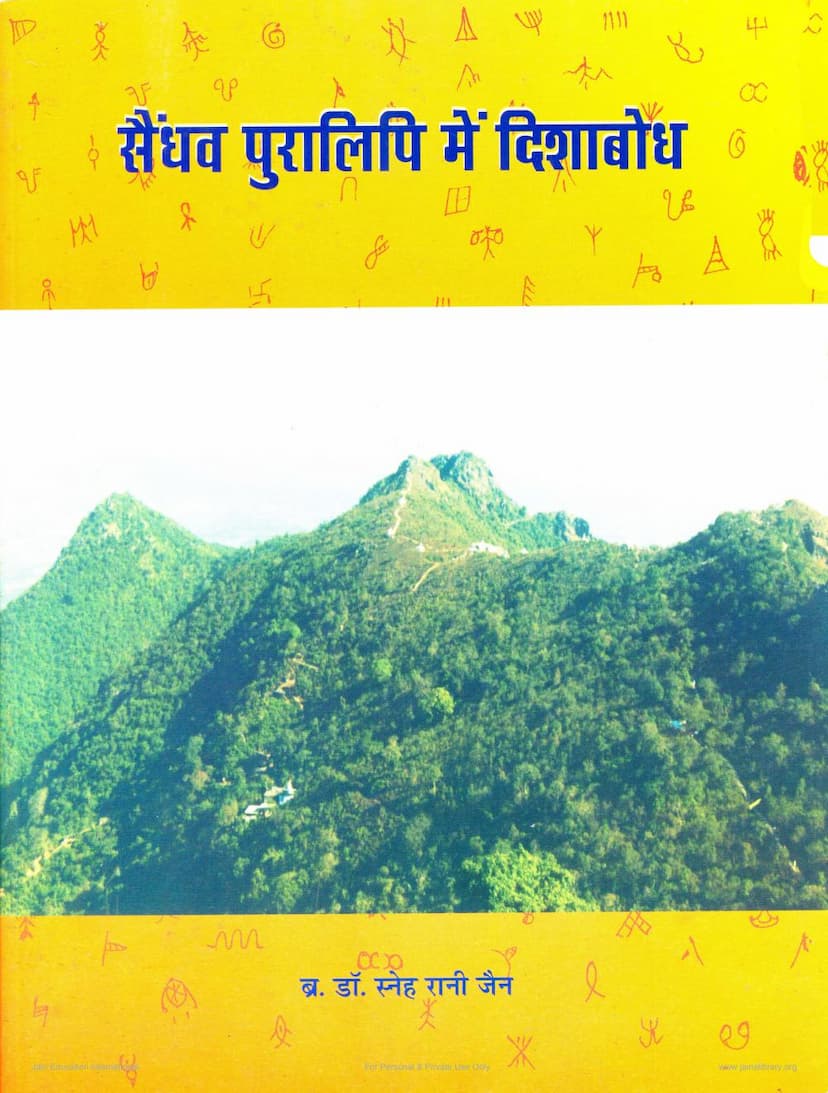Saindhav Puralipime Dishabodh
Added to library: September 2, 2025

Summary
The book "Saindhav Puralipi mein Dishabodh" (Understanding Direction in Saindhav Script) by Brahmacharini Dr. Sneh Rani Jain, published by Int Digambar Jain Sanskrutik Parishad, is a comprehensive exploration of the Indus Valley script from a Jain perspective. The author, a distinguished scholar with a background in microbiology, pathology, and archeology, argues that the Indus script and the civilization it represents are intrinsically linked to Jain principles and philosophy.
The central thesis of the book is that the symbols and inscriptions found in the Indus Valley civilization, often referred to as the Saindhav script, are not merely commercial or administrative notations but are deeply imbued with Jain spiritual concepts and teachings. Dr. Jain posits that by understanding these symbols through the lens of Jain scriptures and spiritual practices, one can decipher the "direction" not only of the script itself but also of the path to spiritual liberation, which she views as the ultimate "direction" for humanity.
Key arguments and findings presented in the book include:
- Reinterpretation of Symbols: Dr. Jain challenges prevailing interpretations of Indus script symbols that often associate them with Vedic or other contemporary traditions. She proposes that many symbols, when understood in the context of Jain philosophy, reveal profound spiritual meanings. For instance, the tripartite symbol (three apexes) and the womb sketch are interpreted as representations of Jain concepts like the three jewels (Ratnatraya), the cycle of rebirth (Samsara), and the path to liberation.
- Jain Spiritual Concepts: The book meticulously analyzes various Indus seals and inscriptions, linking them to core Jain tenets such as:
- The Fourteen Purva Texts: The author suggests that some complex Indus inscriptions might represent fragments or echoes of the ancient Jain Purva texts, lost to time but surviving in symbolic form.
- Tapasya (Austerity) and Samyama (Self-control): Numerous seals are interpreted as depicting the practice of severe austerities, meditation (Kāyotsarga), and the discipline of senses, all central to Jain spiritual discipline.
- The Twelve Reflections (Anupreksha): The book explores how concepts like impermanence, suffering, and the nature of the soul, central to Jain contemplation, are symbolically represented in the script.
- The Nine Treasures (Navaratnas): The author links certain symbols to the Jain concept of the nine treasures, which are seen as essential for spiritual progress.
- The Five Great Vows (Mahavratas) and the path to liberation (Moksha): The inscriptions are often seen as illustrating the journey of the soul through different states of existence (four gatis) and the arduous path of liberation.
- The concept of the Jina: The presence of figures in yogic postures and the recurring motifs are interpreted as representations of Jinas, the liberated souls who attained omniscience and showed the path to others.
- The Fourfold Jain Community (Chaturvidha Sangha): The book suggests that symbols might represent the four classes of Jain followers: monks, nuns, laymen, and laywomen.
- Re-evaluation of the Indus Valley Civilization: Dr. Jain presents the Indus Valley Civilization not merely as an advanced urban culture but as a civilization deeply rooted in Jain spiritual practices. She argues that the emphasis on peace, non-violence (ahimsa), vegetarianism, and introspection found in the Indus remains aligns perfectly with Jain philosophy, suggesting an earlier presence of Jain thought in India.
- Direction of Reading: A significant contribution of the book is its analysis of the "direction" of reading the script. Dr. Jain proposes that the directionality is not fixed but often dictated by the context of the symbols, and in many cases, it reflects the flow of spiritual concepts from birth (beginning) to liberation (end). She critiques some previous attempts at decipherment, including that of Iravatham Mahadevan, for not fully grasping this fluid directional aspect, arguing that a Jain perspective is crucial for correct interpretation.
- Identification of Key Symbols: The book provides extensive lists and interpretations of various Indus symbols, relating them to Jain principles. It highlights the significance of symbols like the swastika, the bulls, the unicorn-like figures, the pitchers, and various geometric patterns, interpreting them within the framework of Jain cosmology and spiritual practices.
- Reconstruction of History: The author contends that the prevailing historical narratives often overlook or misinterpret the Jain influence on early Indian civilization. She advocates for a re-evaluation of history based on archaeological evidence that aligns with Jain traditions, suggesting that the Indus Valley Civilization was, in essence, an early manifestation of Jain culture.
The book is meticulously researched, drawing upon a vast array of archaeological findings, ancient Jain texts, and scholarly works on linguistics and epigraphy. Dr. Jain's scientific background is evident in her rigorous approach to evidence, while her deep spiritual understanding of Jainism provides the crucial interpretive framework. The book includes numerous illustrations of seals, pottery, and rock inscriptions to support her arguments.
In essence, "Saindhav Puralipi mein Dishabodh" is a groundbreaking work that attempts to bridge the gap between archeology and Jain spirituality, proposing a revolutionary understanding of the Indus Valley script and civilization as an ancient expression of Jainism. It calls for a re-examination of Indian history through a Jain lens, highlighting the profound and enduring influence of Jainism on the subcontinent's cultural and spiritual landscape.